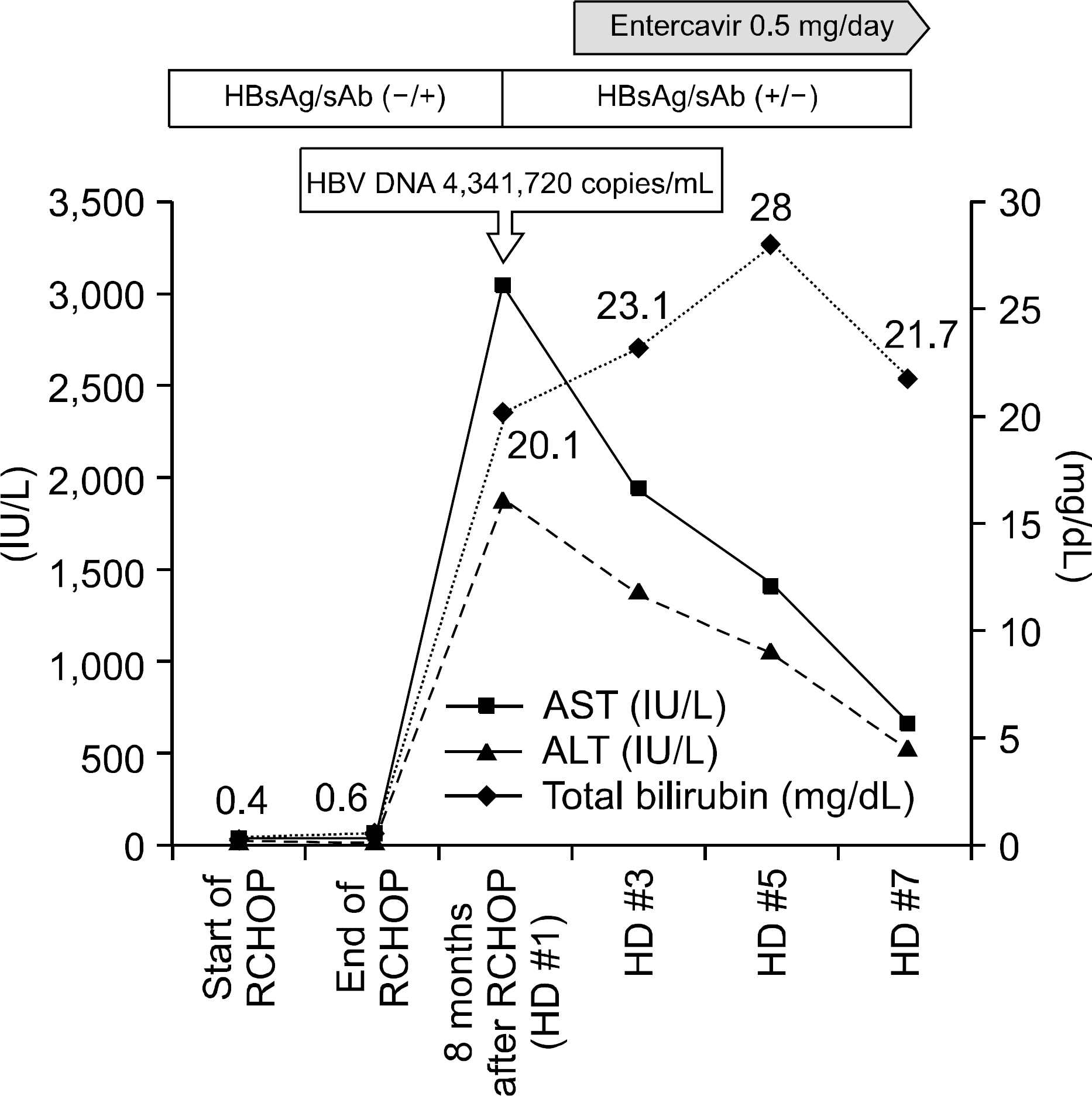Fulminant Hepatic Failure with Hepatitis B Virus Reactivation after Rituximab Treatment in a Patient with Resolved Hepatitis B
- Affiliations
-
- 1Department of Internal Medicine, Guri Hospital, Hanyang University College of Medicine, Guri, Korea. sonjh@hanyang.ac.kr
- KMID: 1792779
- DOI: http://doi.org/10.4166/kjg.2010.55.4.266
Abstract
- It is well known that the reactivation of hepatitis B virus (HBV) may occur as an acute hepatitis after chemotherapy or immunosuppressive therapy. Although most of these cases have been reported in HBsAg-positive patients, there have been a few reports of HBV reactivation in HBsAg-negative patients. There have been concerns for the need to screen the reactivation as well as anti-viral prophylaxis in HBsAg-negative patients with possible HBV occult infection who are planning to undergo chemotherapy or immunosuppressive therapy. Rituximab, an anti-CD20 monoclonal antibody, is effective in the treatment of non-Hodgkin's lymphoma. However, rituximab can affect the immunity against HBV, consequently increasing viral replication. In fact, there have been reports of HBV reactivation after treatment with rituximab. Here, we report a case of HBV reactivation following rituximab plus systemic chemotherapy in diffuse large B cell lymphoma patient who was HBsAg negative, anti-HBs positive, and anti-HBc positive, ultimately leading to treatment-unresponsive fulminant hepatic failure.
Keyword
MeSH Terms
-
Aged
Antibodies, Monoclonal/*therapeutic use
Antineoplastic Agents/*therapeutic use
Antiviral Agents/therapeutic use
DNA, Viral/analysis
Female
Guanine/analogs &derivatives/therapeutic use
Hepatitis B/*diagnosis/drug therapy
Hepatitis B virus/isolation &purification
Humans
Liver Failure, Acute/*diagnosis
Lymphoma, Large B-Cell, Diffuse/*drug therapy
Recurrence
Figure
Cited by 3 articles
-
Occult Hepatitis B Virus Infection: Transmission and Reactivation
Sang Hee Song, Seong Gyu Hwang
Korean J Gastroenterol. 2013;62(3):148-153. doi: 10.4166/kjg.2013.62.3.148.HBV reactivation in a HBsAg-negative patient with multiple myeloma treated with prednisolone maintenance therapy after autologous HSCT
Ha Ra Gu, Dong-Yeop Shin, Hong Seok Choi, Chae Ho Moon, Su Cheol Park, Hye Jin Kang
Blood Res. 2015;50(1):51-53. doi: 10.5045/br.2015.50.1.51.A Case of Reactivation of Hepatitis B and Fulminant Hepatitis which developed 3 months following Chemotherapy Including Rituximab in a Patient with Lymphoma
Tae Won Lim, Hee Taek Oh, Seung Un Song, Hae Won Lee, Ji Yeon Kim, Seon Ja Park
Kosin Med J. 2014;29(2):161-168. doi: 10.7180/kmj.2014.29.2.161.
Reference
-
1. Gupta S, Govindarajan S, Fong TL, Redeker AG. Spontane-ous reactivation in chronic hepatitis B: patterns and natural history. J Clin Gastroenterol. 1990; 12:562–568.2. Conjeevaram HS, Lok AS. Occult hepatitis B virus infection: a hidden menace? Hepatology. 2001; 34:204–206.
Article3. Tsutsumi Y, Kanamori H, Mori A, et al. Reactivation of hepatitis B virus with rituximab. Expert Opin Drug Saf. 2005; 4:599–608.
Article4. Lok AS, McMahon BJ. Chronic hepatitis B. Hepatology. 2007; 45:507–539.
Article5. Kim EB, Kim DS, Park SJ, Park Y, Rho KH, Kim SJ. Hepatitis B virus reactivation in a surface antigen-negative and antibody-positive patient after rituximab plus CHOP chemotherapy. Cancer Res Treat. 2008; 40:36–38.
Article6. Lim SM, Jang JW, Kim BW, et al. Hepatitis B virus reactivation during chlorambucil and prednisolone treatment in an HBsAg-negative and anti-HBs-positive patient with B-cell chronic lymphocytic leukemia. Korean J Hepatol. 2008; 14:213–218.7. Yeo W, Chan PK, Zhong S, et al. Frequency of hepatitis B virus reactivation in cancer patients undergoing cytotoxic chemotherapy: a prospective study of 626 patients with identi-fication of risk factors. J Med Virol. 2000; 62:299–307.
Article8. Hu KQ. Occult hepatitis B virus infection and its clinical implications. J Viral Hepat. 2002; 9:243–257.
Article9. Dervite I, Hober D, Morel P. Acute hepatitis B in a patient with antibodies to hepatitis B surface antigen who was receiving rituximab. N Engl J Med. 2001; 344:68–69.
Article10. Sera T, Hiasa Y, Michitaka K, et al. Anti-HBs-positive liver failure due to hepatitis B virus reactivation induced by rituximab. Intern Med. 2006; 45:721–724.
Article11. Yamagata M, Murohisa T, Tsuchida K, et al. Fulminant B hepatitis in a surface antigen and hepatitis B DNA-negative patient with diffuse large B-cell lymphoma after CHOP chemotherapy plus rituximab. Leuk Lymphoma. 2007; 48:431–433.
Article12. Tur-Kaspa R, Burk RD, Shaul Y, Shafritz DA. Hepatitis B virus DNA contains a glucocorticoid-responsive element. Proc Natl Acad Sci USA. 1986; 83:1627–1631.
Article13. Yeo W, Chan TC, Leung NW, et al. Hepatitis B virus reactivation in lymphoma patients with prior resolved hepatitis B undergoing anticancer therapy with or without rituximab. J Clin Oncol. 2009; 27:605–611.
Article14. Hui CK, Cheung WW, Zhang HY, et al. Kinetics and risk of de novo hepatitis B infection in HBsAg-negative patients undergoing cytotoxic chemotherapy. Gastroenterology. 2006; 131:59–68.
Article15. van der Kolk LE, Baars JW, Prins MH, van Oers MH. Rituximab treatment results in impaired secondary humoral immune responsiveness. Blood. 2002; 100:2257–2259.
Article
- Full Text Links
- Actions
-
Cited
- CITED
-
- Close
- Share
- Similar articles
-
- A case of fulminant hepatic failure complicating hepatitis A virus superinfection in a hepatitis B virus carrier
- Reactivation of Hepatitis B Virus and Its Prevention in Patients with Rheumatic Diseases Receiving Immunosuppressive Therapy
- A Case of Reactivation of Hepatitis B and Fulminant Hepatitis which developed 3 months following Chemotherapy Including Rituximab in a Patient with Lymphoma
- Hepatitis B Virus Reactivation after Partial Hepatic Irradiation Alone: A Case Report
- A Case of Hepatitis B Virus Reactivation in a HBsAg-Negative and Anti-HBs-Positive Patient with Diffuse Large B-Cell Lymphoma after Rituximab plus CHOP Chemotherapy


